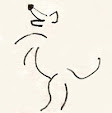By Carol Labashosky
Three dedicated and hard-working worldwide photographers told their stories to Louisvillians at Mellwood Arts Center, Louisville, Ky., United States on Oct. 22. We all can't capture David Bowie live on stage, document Chinese Turkestan culture, or showcase the hauntingly beautiful but tragic African Rwanda, but I'm sure glad as hell these Canadian fellows did. I came away freshly inspired and thankful for those who take the time to share their mighty fine art.
Here are experts of their fascinating lectures in stories uniquely their own.
Barrie Wentzell began by quipping, "I haven't done a show on a bed sheet (aka improvised slide screen for the show) before."
Barrie lives in Toronto, but hails from England where he did some of his best work shooting rock and rollers - even before they were richly famous, for Melody Make magazine in the 60s. He had started his career by capturing scenes of people doing their "daily life" and graduated to the likes of musicians doing their daily life such as Alice Cooper, Ron Wood, Neil Young, Jimi Hendrix, Brian Ferry, Chuck Barry and Diana Ross and the Supremes. In 1966 he caught the Rolling Stones, a big coups, and then John Lennon with Yoko and even theThe Beatles.
"He was always nattily dressed," Wentzell said, about one of these guys (?!?). When Barrie spoke, he relayed his English accent in such an entertaining manner, making him wonderful to listen to. Barrie said he'd begin his face-to-face chats with rockers to "just talk to them" making them feel at ease before putting a camera to their faces. "Gradually, you become invisible."
Wentzell said early in Elton John's career, he was initially quiet and shy during a photo session - "boring."
"So I took him up to Primrose Hill. When (a subject is) boring, you put him in an environment that's interesting..." The photos ended up starkly contrasted with a snowy hill, with a couple walking some dogs far in the background, while Elton, in the foreground, simply stood there; he was given a very cool "stage."
Barrie hated the camera flash, and preferred natural light. I asked him if he carries a camera with him, and he said, "Not anymore, but maybe someday I'll get a digital camera." Whatta clever fellow, who would, in the day, carry around a Pentax camera, a couple of camera bodies, and only a bit of lighting equipment to do a job he loved.
Russell Monk is a photojournalist who “dragged people off the street” into his apartment to shoot: a shoe salesman with a shoe, a butcher with his head obscured by a pig's head. He shoots with a Roloflex camera. His first photo even sold for profit was for a business annual report which surprised him and the audience. He then got more and more editorial work and magazine assignments, things such as: the Canadian President, the homeless in Tennessee, shelters, and his photos got into the Museum of Civil Rights. He shoots primarily in black and white with a 4 x 5 inch box camera with tripod. "If the pictures made money, I always gave some money back. One day, I got a bus, and drove around getting 200 pairs of shoes, and underwear for those poor I had photographed (at a hospital or shelter)."
"The photos I did for myself appeared as photograph spreads in magazines.
" Scenes such as Mexico's Day of the Dead, Rwanda, Albania, Belfast, Hanoi and picturesque mountains in Tibet, sick children...the starving.
"...I saw the dichotomy of how beautiful a photograph can be, but too beautiful (in the depressing circumstances). People wonder, and I wonder, how can people do this (take pictures of atrocity); I realized somebody had to photograph it.
"I shot Polaroid, so I could give them (the subjects) a picture and give something back."
Ryan Pyle's lecture on "Chinese Turkestan” was his quest to live and breathe the life of his subjects alongside them, day to day, FOR YEARS! He's lived near the Muslim province, but in Shanghai, so he can visit northwest China, as his life’s work since 2002. He shoots black and white Kodak film with small range-finder cameras. "I've spent my life trying to be invisible. It requires a lot of patience. It takes time to build trust with subjects.”
Before he moved to that - what I call remote part of the globe - place, near Kazakhstan, or “The Silk Highway,” he had no interest in photography.
"I conscientiously decided to look at the culture, sociology, anthropology……because of development and growth of the area, the architecture is disappearing.
"I try to get under the skin of people there.
"I am trying to learn about the way these people live in every way."
And it sure is subsistence living, stark and hard, where work trumps social life. Herding, selling goods at the evening markets, mountains or city pictures. It's a Muslim world with Islamic writing where the women are covered. His photos are beautiful, and you really get to feel this unusual part of the world with these richly textured photos. Near a mosque, Ryan tells us, as he shows pictures of beggars with crutches, that this behavior is tolerated, and they are given money. He said people burn coal and animal dung during the morning to start the day for tea and such, and that there is a haze in some of the pictures that is not underexposure (?!).
Ryan says he'll stay there for his career. That's good for us, here in the U.S., and good for him, too, as his creativity blooms.
To learn more, visit artists' web sites or Mellwood Arts Center (just do googles - you'll be glad you did). Exhibits still on display! Canadians Invade Louisville by Elevatorexhibitions.com



